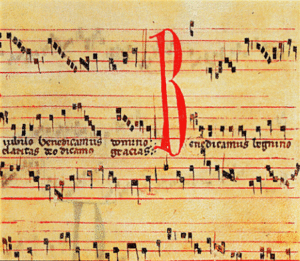Las Huelgas Codex facts for kids
The Codex Las Huelgas is a very old music book, or manuscript, from around the year 1300. It was created and kept at the Cistercian convent of Santa María la Real de Las Huelgas in Burgos, a city in northern Spain. This convent was very rich and had strong connections with the royal family of Castile.
This special book contains 45 pieces of monophonic music (music with one melody). It also has 141 pieces of polyphonic music (music with many different melodies played at the same time). Most of the music is from the late 1200s. Some pieces are even older, from the early 1200s. A few pieces were added later, in the early 1300s. Many of these songs cannot be found in any other music books.
The Codex is written on parchment, which is like a very old type of paper made from animal skin. The music lines, called staves, are drawn in red ink. The musical notes use a style called Franconian notation.
Most of the book was written by one person. However, about 12 different people helped with it. They made corrections or added new music later. A person named Johannes Roderici (also known as Juan Rodríguez) wrote his name in several places. He might have written a few of the songs himself. He also worked as a scribe (someone who copies texts), a compiler (someone who puts things together), and a corrector.
The music in the Codex was meant to be performed. It was likely sung within the monastery. At one point in the 1200s, this monastery had a choir of 100 women.
Contents
Music for a Women's Choir
The Codex Las Huelgas makes us wonder how the music was performed. This is especially true for the polyphonic songs. It is thought that the women's choir at the convent sang these pieces. This is interesting because Cistercian rules usually did not allow polyphonic music.
However, music with two parts seems to have been allowed. In 1217, a church meeting complained about two English abbeys. They were singing in three or four parts, like churches outside monasteries. This suggests that singing in two parts was okay. The Codex even has two-part singing exercises. It also has notes about how to use them in the convent. There are also some pieces in the book that have three parts.
How the Codex Was Found
The Codex was found again in 1904. Two Benedictine monks discovered it. They were studying Gregorian chant, which is a type of old church music.
However, the music from the Codex was not published until the 1930s. This means people could not easily read or play it until then. Another version of the music was published in the 1980s.
Groups That Perform This Music
Several music groups have performed and recorded music from the Codex Las Huelgas.
The Huelgas Ensemble
The Huelgas Ensemble is a group from Belgium. They specialize in polyphony, which is music with many voices. The group was started in 1971. They named themselves after the Codex. They have performed many important early Spanish and Portuguese songs, including much music from this special book.
Other Notable Recordings
Many other groups have recorded music from the Codex.
- Sequentia (Ensemble Sequentia, Köln) recorded "Codex Las Huelgas: Music from the Royal Convent of Las Huelgas de Burgos, 13-14th C." in 1992.
- Anonymous 4 is a women's a cappella group. This means they sing without instruments. They released an album called "Secret Voices: Chant and Polyphony from the Las Huelgas Codex" in 2011.
- Ars Combinatoria was started in 1991. This group wanted to be able to play any type of music from any time period. They released an album called "Mulier Misterio. El Códice de las Huelgas. Musaris" in 2017.
See also
 In Spanish: Codex Las Huelgas para niños
In Spanish: Codex Las Huelgas para niños


